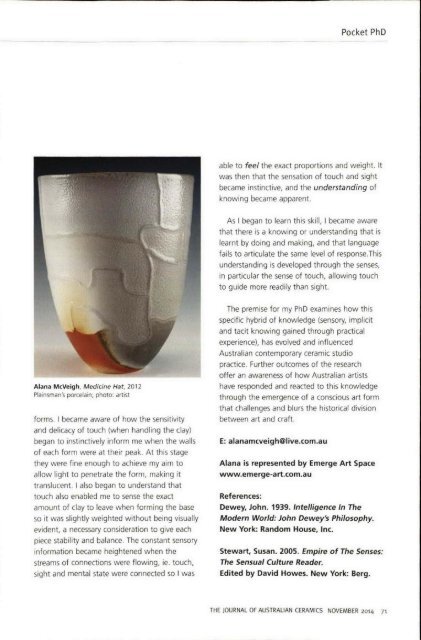The Journal of Australian Ceramics Vol 53 No 3 November 2014
Create successful ePaper yourself
Turn your PDF publications into a flip-book with our unique Google optimized e-Paper software.
Pocket PhD<br />
able to feel the exact proportions and weight. It<br />
was then that the sensation <strong>of</strong> touch and sight<br />
became instinctive, and the understanding <strong>of</strong><br />
knowing became apparent.<br />
As I began to learn this skill, I became aware<br />
that there is a knowing or understanding that is<br />
learnt by doing and making, and that language<br />
fails to articulate the same level <strong>of</strong> response.This<br />
understanding is developed through the senses,<br />
in particular the sense <strong>of</strong> touch, allowing touch<br />
to guide more readily than sight.<br />
Alana M cVeigh, Medicine Ha t, 2012<br />
Plainsman's porcelain; photo: artist<br />
forms. I became aware <strong>of</strong> how the sensitivity<br />
and delicacy <strong>of</strong> touch (when handling the clay)<br />
began to instinctively inform me when the walls<br />
<strong>of</strong> each form were at their peak. At this stage<br />
they were fine enough to achieve my aim to<br />
allow light to penetrate the form, making it<br />
translucent. I also began to understand that<br />
touch also enabled me to sense the exact<br />
amount <strong>of</strong> clay to leave when forming the base<br />
so it was slightly weighted without being visually<br />
evident, a necessary consideration to give each<br />
piece stability and balance. <strong>The</strong> constant sensory<br />
information became heightened when the<br />
streams <strong>of</strong> connections were flowing, ie. touch,<br />
sight and mental state were connected so I was<br />
<strong>The</strong> premise for my PhD examines how this<br />
specific hybrid <strong>of</strong> knowledge (sensory, implicit<br />
and tacit knowing gained through practical<br />
experience), has evolved and influenced<br />
<strong>Australian</strong> contemporary ceramic studio<br />
practice. Further outcomes <strong>of</strong> the research<br />
<strong>of</strong>fer an awareness <strong>of</strong> how <strong>Australian</strong> artists<br />
have responded and reacted to this knowledge<br />
through the emergence <strong>of</strong> a conscious art form<br />
that challenges and blurs the historical division<br />
between art and craft.<br />
E: alanamcveigh@live.com.au<br />
Alana is represented by Emerge Art Space<br />
wwvv.emerge-art.com.au<br />
References:<br />
Dewey, John. 1939. Intelligence In <strong>The</strong><br />
Modern World: John Dewey's Philosophy.<br />
New York: Random House, Inc.<br />
Stewart, Susan. 2005. Empire <strong>of</strong> <strong>The</strong> Senses:<br />
<strong>The</strong> Sensual Culture Reader.<br />
Edited by David Howes. New York: Berg.<br />
THE JOURNAL OF AUSTRALIAN CERAMICS NOVEMBER <strong>2014</strong> 71

















